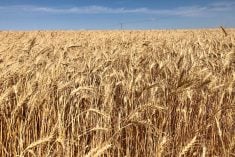CNS Canada – For farmers able to nurse their durum across the finish line this harvest, prices in the winter could make it worth their while.
Withering heat and dry conditions have taken a toll on durum yields, especially in southern regions of the Prairies, but analysts like John Duvenaud of the Wild Oats Grain Market Advisory, have big hopes for the quality.
“Durum is one of the big success stories this year,” Duvenaud said.
While he cautioned it is still too early to assess the crop definitively with harvest not yet started in most areas, he said yields appear about average.
Read Also

India slaps 30 per cent import duty on yellow peas
India has imposed a 30 per cent duty on yellow pea imports with a bill of lading date on or after Nov. 1, 2025.
That’s a long ways off last year’s larger-than-normal harvest, but 2016 also saw growers facing quality problems.
With durum crops also reduced in the United States, the European Union, Kazakhstan and Syria, that should support prices at current levels of about C$10 per bushel.
“I would sell some off the combine; I would sell incrementally. Ten bucks a bushel, nothing wrong with that. So move some out, but I wouldn’t be super aggressive about it. I would dole it out through the year,” Duvenaud said.
Neil Townsend at FarmLink said he’s also bullish about the year ahead.
A Statistics Canada report released in June showed durum seeded acreage this spring was about 15 per cent lower than last year. Add to that this year’s weather issues and it should further weigh on supplies.
However, Townsend pointed out that because much of last year’s large crop came in at lower grades, stockpiles disappeared more quickly than usual, as more went for livestock feed or was discarded.
Carry-in stocks for this growing season were pegged at 2.1 million tonnes by Agriculture Canada, while FarmLink has a slightly lower carry-in at 1.86 million tonnes.
He said that supply could have a small cooling effect on prices.
“Just to show that’s the highest carry-out stocks since 2009-10, so fairly healthy and that kind of gives just a little buffer for what’s being produced now,” he said.
However, he projected ending stocks for 2017-18 would be below one million tonnes.
“The last time they were like that was 2007-08, and that was — we had explosive durum prices at that time,” he said.
Townsend said he doesn’t expect prices are heading up to those levels again, but they should stay strong for top grades.
“It’s a smaller pile of better stuff,” he said.
He added North Dakota and Montana durum is also shriveling under heat, which should prompt U.S. outlets to become eager buyers of Canadian durum throughout the marketing year.
On the downside, he said better-than-average durum crops in Algeria, Tunisia and Morocco, who represent the largest durum importers, may encourage those nations to reduce imports.
As well, he said Russia remains a relative unknown. Although it has reported a good wheat crop, it’s not known how much of that is durum.
“But if the price is right, you’ll see lots of arbitrage opportunities,” Townsend said.
He added farmer behaviour may yet play a role too.
“Particularly in the U.S., in some of the hard-core durum areas particularly, they (farmers) will hold that stuff very dearly. It’s hard to extract it from them.”
However, many buyers have been aware of that situation for some time already, Townsend said, and have forward contracted, which gives them the ability to better choose their buying opportunities.
“I think prices are going to be strong. I don’t know if they’ll be as strong as the weather market extremes,” he said.
Townsend predicted durum prices may slip in October, as often occurs following harvest, but then pick up again in February, March and April, when U.S. lake shipping opens up. March is also when North Africa nations start their new season and any difficulties there would also be reflected in the market.
The latest Saskatchewan crop report showed the condition for the durum now in fields to be just two per cent excellent and 19 per cent good. The rest of the current crop was rated 49 per cent fair, 26 per cent poor and four per cent very poor.












